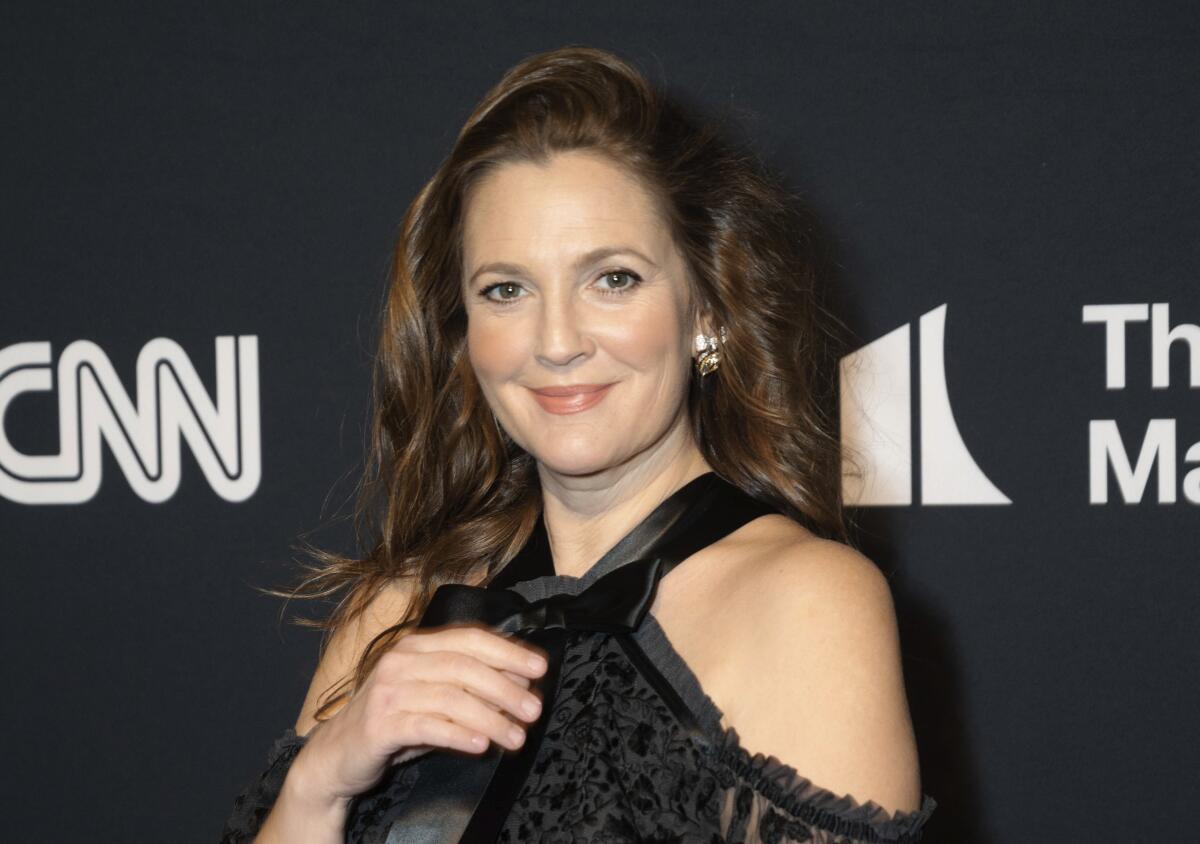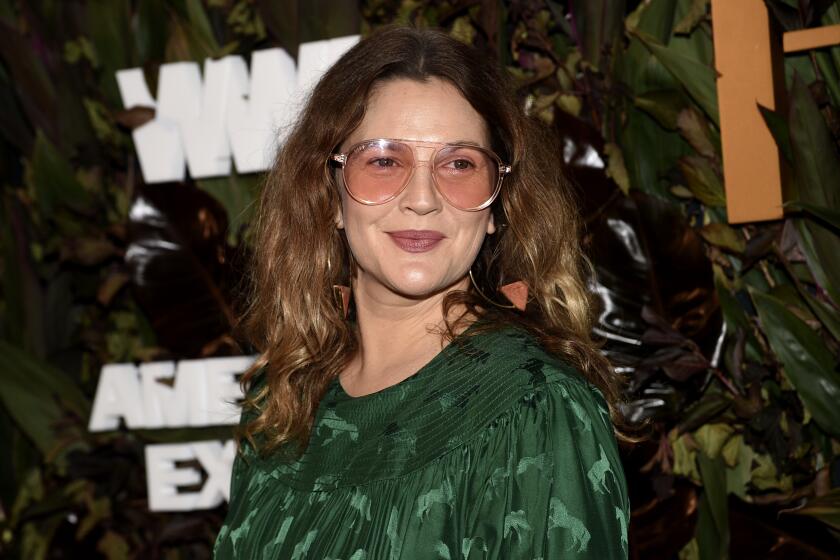Drew Barrymore spent years building her brand. Without writers, it unraveled in a week

- Share via
A good writer can come in handy in the middle of a crisis.
Just ask Drew Barrymore.
In her own cheerfully chaotic way, the former child star-turned-quirky daytime host has shown the power of a carefully crafted celebrity narrative — and the ease with which even the most convincing comeback story can fall apart.
On Sunday, after a week of mounting backlash over her decision to go back into production on her daytime talk show, which employs members of the Writers Guild of America who are currently on strike, Barrymore issued the latest in a series of statements on Instagram.
This time, as if to acknowledge the damage the preceding days had caused her reputation, she announced that “The Drew Barrymore Show” would “pause the show’s premiere” until after the strike is over. (CBS Media Ventures, which produces the show, confirmed that it would also halt production. On Sunday, CBS also announced postponement of Season 14 of “The Talk” amid mounting scrutiny over daytime talk shows returning during the writers’ and actors’ strikes.)
“I have no words to express my deepest apologies to anyone I have hurt and, of course, to our incredible team who works on the show and has made it what it is today,” Barrymore wrote. “We really tried to find our way forward. And I truly hope for a resolution for the entire industry very soon.”
That “way forward” was, to say the least, a winding one — a week from PR hell that began Sept. 10, when she announced that she was resuming production on her daytime talk show amid the ongoing strike by the WGA.
With successful pressure campaigns against Drew Barrymore, Bill Maher and others, the WGA displayed its might on the eve of a new round of negotiations.
“I want to be there to provide what writers do so well, which is a way to bring us together or help us make sense of the human experience,” she wrote in the initial post, which has since been deleted. “I hope for a resolve for everyone as soon as possible. We have navigated difficult times since we first came on air. And so I take a step forward to start season 4 once again with an astute humility.”
The statement, with awkward and so-very-Drew phrases like “an astute humility,” demonstrated the value of professional writers.
Drew Barrymore posts weepy video ‘deeply apologizing’ to writers, then doubles down on show’s return
Drew Barrymore issues a tear-filled video ‘deeply apologizing’ to writers and unions, then doubles down on her talk show’s return to production during strikes.
It also prompted a swift and ferocious backlash against a freakishly resilient star who endured so much scrutiny during her turbulent childhood and rebellious adolescence that, as an adult, she has largely floated above criticism, seeming almost immune to damaging scandal.
That is, until now.
After the Sept. 10 announcement, the WGA immediately set up a picket line outside the studio in Manhattan. Audience members wearing WGA pins were kicked out of a taping. The National Book Foundation announced that it had rescinded Barrymore’s invitation to host the group’s annual awards ceremony. “Our commitment is to ensure that the focus of the Awards remains on celebrating writers and books,” the group said in a statement. On the platform formerly known as Twitter, professional writers piled on Barrymore with a kind of glee formerly reserved for Warner Bros. Discovery Chief Executive David Zaslav.
Even the Onion weighed in with the tongue-in-cheek headline, “Drew Barrymore Opens GM Assembly Plant Amid Impending Autoworker Strike.” When your once-beloved name becomes so synonymous with “scab” that it can be used in effective satire, you’re probably doing something wrong.
If the cast and writers of “Saturday Night Live” weren’t also on strike, Chloe Fineman would surely be prepping a Barrymore-themed sketch for the next episode.
The fallout seemed to reach its greatest extent Friday, when Barrymore posted a tearful nonapology to Instagram.
In the video — filmed against a rustic, ropy wall hanging in what appears to be the primary bedroom of her Hamptons home — Barrymore apologized to writers and to unions, but doubled down on her decision, framing it as yet another hardship she has had to face in the public eye.
“I’ve been through so many ups and downs in my life,” she said. “And this is one of them.”
Barrymore’s video, with its strategically modest mise-en-scène and overwrought delivery, instantly invited comparisons to the disastrous pseudo-apology that Mila Kunis and Ashton Kutcher posted to Instagram last week for writing letters in support of convicted rapist Danny Masterson.
On Saturday, actors Ashton Kutcher and Mila Kunis spoke out about the letters they wrote to the judge asking for leniency in their “That ‘70s Show” costar Danny Masterson’s recent rape sentencing.
By Friday evening, as peers including Bradley Whitford and Alyssa Milano spoke out against her, Barrymore had already taken the video down.
As a result of these missteps, Barrymore managed to squander much of the goodwill she stockpiled over more than four decades in the business, including three years as a growing force in daytime TV. With a few ill-advised social media posts, the savvy producer of hits like “Charlie’s Angels” punctured her carefully honed image as an endearing kook and excruciatingly sincere Hollywood survivor who learned to embrace her eccentricities rather than let the industry wring them out of her. Fans were left to wonder whether America’s adorkable sweetheart was just doing a bit the whole time.

Some have wondered why Barrymore has seemingly been singled out for such fierce criticism when other shows have gone back into production while the strike endures, including “Real Time With Bill Maher.”
Part of the anger stemmed from the fact that Barrymore opened the floodgates, enabling others to cross the picket lines with less scrutiny. Surely there were dozens of conversations in the last week along the lines of: “If Drew did it, why can’t we?” By deciding to go back into production, Barrymore did as much to fire up striking writers as any unnamed executive quoted in Deadline.
Barrymore also justified her initial decision to resume production by saying that the show “is bigger than me” — an implicit nod to the many crew members on her payroll. But by her own admission, the show went dark before the strike began in May and was on a previously scheduled hiatus throughout the summer. The strike hadn’t disrupted her plans or caused months of unanticipated hardship for her employees — yet.
The truth is, we’ve come to expect this kind of behavior from Maher, a professional contrarian who delights in undermining liberal orthodoxies. Barrymore, on the other hand, is — or at least was — cherished by so many precisely because she hadn’t withered under pressure from Hollywood or let the ruthlessness of the industry turn her into another showbiz phony.
Barrymore’s entire brand is about authenticity, kindness and an earnestness so pure that it can melt the icy heart of the most committed cynic. (Just look at how much she enjoys rain!) She may have been born into dysfunctional showbiz royalty, but she wasn’t a creature of Hollywood. And viewers have been on her side — at least, those of us of a certain generation have — since she became an international celebrity at age 7.
Bill Maher’s HBO show ‘Real Time With Bill Maher’ is returning without ‘writers or writing.’
When it comes to Barrymore, I’m reminded of the moment in “America’s Next Top Model” when Tyra Banks scolded a contestant for her underwhelming performance, which has now been immortalized as one of the internet’s favorite GIFs.
To paraphrase Tyra: I was rooting for you, Drew. We were all rooting for you, through every bad movie, every unfortunate haircut or lipstick choice, even through the short-lived marriage to Tom Green, which seemed weird at the time but was honestly kind of sweet in retrospect.
Her travails are well known. She was hosting “SNL” before she lost all her baby teeth, but Barrymore’s home life was a mess. She descended into drug and alcohol abuse and, by age 14, she was in rehab, considered a has-been in the industry.
But she started changing the narrative at 15, when she published an unflinching memoir, “Little Girl Lost,” which, it’s worth noting, was written with a professional author, Tony Gold.
She staged a comeback, starring in a string of projects that played up her bad-girl image, including “Poison Ivy” and — deep sigh — “The Amy Fisher Story.” She was subjected to the salivating misogyny and egregious double standards that were endemic to entertainment journalism of the era, portrayed as a dangerous Lolita type in magazine profiles. (Karina Longworth unpacks the madness around Barrymore in an excellent episode of her podcast, “You Must Remember This.”) Barrymore sometimes acted in ways that seemed to play up this caricature, flashing her breasts to David Letterman on TV, for instance. But she was young and free-spirited, and we were all just glad she was alive.
Once she reached her 20s and 30s, she moved away from edgy material and rebranded herself — yet again — as a wacky and highly bankable everywoman, starring in the romantic comedies “Never Been Kissed,” “The Wedding Singer” and the underrated classic “Music and Lyrics.”
She also branched out into producing and became a savvy Hollywood player who made fun but empowering female-centered projects like “Charlie’s Angels.” The name of her company, Flower Films, captured the sunny yet untamed image she was trying to cultivate, as did “Wildflower,” her second memoir.
Her latest career incarnation, as a divorced mom of two, lifestyle entrepreneur and daytime host, saw her apparently unrehearsed demeanor perfectly matched to the moment: “The Drew Barrymore Show” launched in September 2020, when COVID-19 was still raging, and through ratings were modest, her loopy, off-kilter approach to the format won her a devoted fan base. Barrymore interviewed actors in character as Josie Geller from “Never Been Kissed” and was known to roll around on the floor, or burst into tears when Steven Spielberg stopped by.
As Barrymore told The Times earlier this year, she’d taken a hiatus from acting for several years because the job wasn’t “emotionally available to me right now,” presumably because she was tired of being someone other than herself on camera. Network executive Elaine Bauer Brooks, who pitched Barrymore on the gig, recalled telling her that in daytime, “It’s not enough to just be well known — you need a certain relatability and warmth. When we met, I asked her: ‘Why do you think you can do this?’ And she said: ‘Because I am who you think I am.’”
Whether Barrymore’s decision to halt production and delay the season premiere will repair the damage of the last week remains to be seen. Her initial instinct to put her show’s survival ahead of striking writers may be forgiven but not forgotten, as it were.
For the record:
1:22 p.m. Sept. 17, 2023An earlier version of this story misidentified Rosie O’Donnell as the source of unsolicited advice to Drew Barrymore. O’Donnell was sharing an excerpt from a piece by writer Elizabeth Grey.
Still, Barrymore does appear to have heeded — at least to an extent — the advice of her critics. Over the weekend Rosie O’Donnell, another actor turned daytime star, took to Instagram to share a Substack letter by writer Elizabeth Grey urging Barrymore to stop taping the show and offering some unsolicited PR advice: “Ask someone to craft you three declarative sentences. They should follow along these lines: I made an error. I apologize to the WGA for disrespecting the work of professional writers. I apologize to all union members who are withstanding real hardship as I live a life of luxury.”
In other words: time to bring in the professionals.
Times staff writer Christi Carras contributed to this report.
More to Read
The complete guide to home viewing
Get Screen Gab for everything about the TV shows and streaming movies everyone’s talking about.
You may occasionally receive promotional content from the Los Angeles Times.










